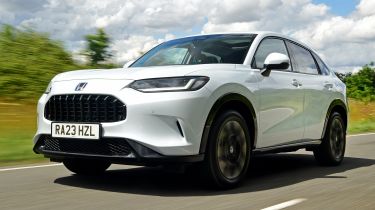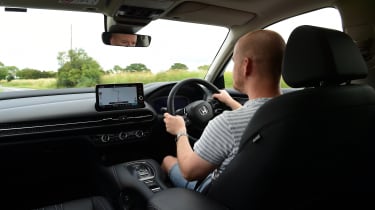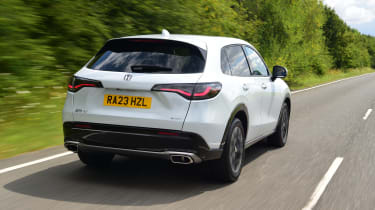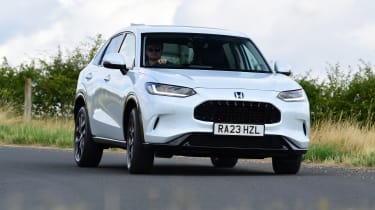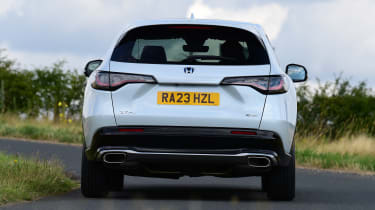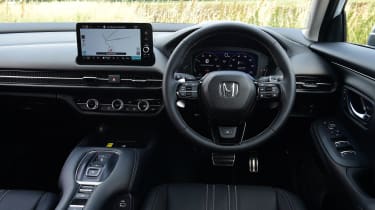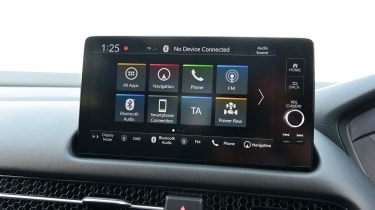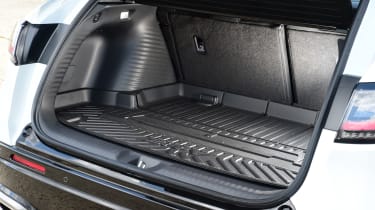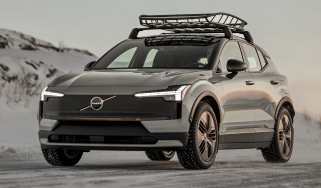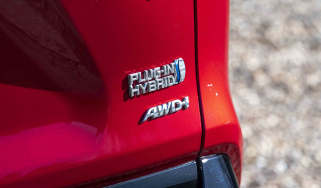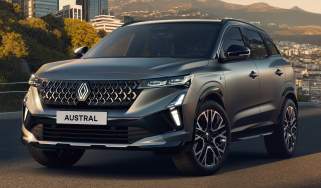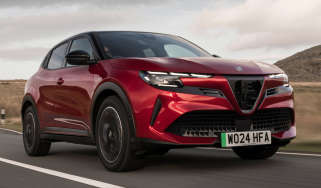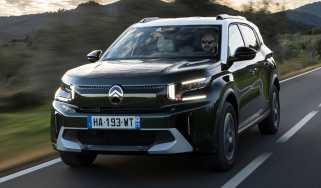Honda ZR-V review - great handling, but expensive
“The new Honda ZR-V is a good but not class-leading rival in the family crossover class”
Pros
- Very efficient
- Well-equipped
- Good to drive
Cons
- Rivals are more comfortable
- Some lacklustre interior details
- Pricey
Verdict - Is the Honda ZR-V a good car?
The ZR-V is a good effort from Honda but not a class-leading SUV. It scores well for space, equipment levels and comfort, and the in-car tech is easy to use. However, there isn’t the polish here we’ve come to expect from Honda, with both the cabin design and the way the ZR-V drives falling short of the high standards set by the mechanically similar Honda Civic. Despite a decently-sized boot, it doesn’t quite offer the luggage space of some rivals either, while relatively high pricing bumps up otherwise competitive vehicle tax figures too – though excellent real-world efficiency still makes it easy to recommend.
Honda ZR-V models, specs & alternatives
Honda has added another SUV to its lineup, filling a gap between the long-running CR-V and HR-V models with the new ZR-V. While it’s an all-new name for the brand, the Honda ZR-V is essentially a small SUV based on the latest Honda Civic. To make things more confusing, Honda actually sells this model as the HR-V in North America, but that name is already used by a smaller SUV over here, based on similar underpinnings to the Honda Jazz.
Like the latest Honda Civic, the ZR-V’s styling is much more conservative in comparison to Hondas of old, but we’re a fan of its clean, minimalist look. It’s a design we also think will prove to be appealing to a wider scope of buyers.
There are three trim levels for the ZR-V, kicking off with Elegance, and moving up through Sport onto top-spec Advance – the jump in price between each trim is relatively small, though, with Sport costing around £1,500 than the entry model, and Advance costing around £2,000 on top of that.
More reviews
In-depth reviews
At just under £40,000, the ZR-V is quite pricey, though it’s well equipped as standard, with features like heated seats and sat-nav. Honda expects the mid-spec Sport to be the best seller, with even more kit like wireless charging, tinted windows and a powered tailgate.
The ZR-V gets the same hybrid system as used in the Civic, consisting of a 2.0-litre petrol engine and electric motor, whichever model you go for. Overall power is rated at 181bhp and the ZR-V will dispatch the 0-62mph sprint in 7.9 seconds. Though it’s not particularly racey, the ZR-V is powerful enough, and precise steering means it feels good to drive.
|
Trim levels |
Power options |
|
|
Honda ZR-V alternatives
The new Honda is competing in a busy segment. The Nissan Qashqai will prove the toughest challenge, given its near-permanent position in the UK’s top ten best-sellers list and Honda’s near-permanent absence from that same top ten, but the likes of the Hyundai Tucson and Kia Sportage (and the slightly smaller Niro, also available as a hybrid) may also be on a ZR-V buyer’s radar.
MPG, running costs & CO2 emissions
We’ve come to expect low running costs from the increasing number of plug-in hybrid and fully electric models on the market, but the ZR-V proves it’s still possible to deliver efficient running with more conventional technology, and a combined economy figure of 48.7mpg is not bad at all for a Qashqai-sized crossover. Better still, it’s a figure we’ve found fairly easy to attain in real-world conditions, even when not driving with fuel economy in mind.
That’s paired with CO2 emissions of 131g/km, which again looks high next to pure EVs but means the ZR-V’s first-year VED bill is modest – at least, provided you opt for the Elegance, The price tag of which dips just under the £40,000 mark. ZR-Vs above this point must also pay the surcharge, which comes in at more than £500 per year in years two to six, for alternative-fuel vehicles including hybrids.
|
Model |
Fuel economy |
CO2 emissions |
|
ZR-V Elegance e:HEV |
48.7mpg |
131g/km |
Insurance
All models in the ZR-V range fall into group 35 for insurance on the 1-50 scale. This is surprisingly high, with rivals such as the Qashqai, Tucson and Sportage typically found in the 20s, so it’s likely it’ll cost a little more to insure the Honda than some equivalent models.
Engines, drive & performance
If you head to a showroom and drive the Honda ZR-V and Civic side by side, you’ll find they feel more similar than you might expect at first glance. The two models are based on the same underpinnings, and that means the ZR-V is very car-like to drive, with precise handling and lots of feedback through the steering wheel.
Low-speed driving has always been a hybrid’s natural environment so it’s no surprise to find that the ZR-V feels most at home in town. The drivetrain finds its sweet spot here but you’ll also appreciate the good visibility – the ZR-V is never less than easy to drive.
Unfortunately, the ZR-V’s great handling has come at the cost of some comfort – leave the 20 and 30mph zones and the car’s relatively firm ride becomes more apparent, though it does feel secure on motorway runs. Despite its raised ride height and SUV-influenced styling, the ZR-V is very much a car-based crossover, so don’t get any ideas about off-road driving – there’s no all-wheel drive option here.
|
Model |
Power |
0-62mph |
Top speed |
|
2.0-litre e:HEV |
181bhp |
7.9s |
107mph |
Hybrid models
The ZR-V uses a 2.0-litre four-cylinder petrol engine as part of a hybrid drivetrain, a layout it shares with the Honda Civic. Honda calls it Intelligent Multi Mode Drive, and while it’s certainly clever (and allows the ZR-V to reach nearly 50mpg), it’s functionally similar to several other hybrid models offered by rivals, so most customers will feel at home with the way it behaves.
With 181bhp and 315Nm of torque and around 1,600kg to pull along there’s reasonable performance on offer – Honda quotes a 0-62mph time of 7.9 seconds, though it’s happiest cruising around at low speeds on electric power alone. It’s nippy off the line thanks to that electric torque, and you can spend a lot of time at low speeds without waking the petrol engine. Accelerate harder and the engine kicks in, stepping up revs incrementally to prevent it screaming away, which is a slightly odd feeling. You do sometimes need to work the engine hard to keep up with other traffic though, which can harm efficiency.
Interior & comfort
At a glance the ZR-V’s cabin shares similarities with the Civic, with a similar dashboard layout with vents integrated into a full-width horizontal feature, and like its stablemate, the pairing of a digital instrument cluster ahead of the driver – 10.2 inches in this case, backed up by a heads-up display in Advance trim – with a central, high-mounted nine-inch touchscreen for infotainment.
The fundamentals are sound, with a driving position halfway between a traditional hatchback and an SUV, and excellent visibility. It’s slightly let down by Honda’s choice of materials in some areas, which doesn’t quite match Honda’s usually high standards – it’s well built but feels a little less precise, and we’re not fans of the ergonomics of the unusual centre console design.
There’s no shortage of useful details though, from five individual charging ports throughout the interior – USB-A and USB-C ports along with a wireless charging pad up front, and a pair of USB-C ports in the rear cabin. Notably, Honda has resisted the urge to control the entire cabin through an infotainment screen, so the car retains physical controls for most functions, and buttons rather than touch-sensitive pads on the steering wheel too.
Key features | |
|
Elegance
|
Sport (Elegance plus…)
|
|
Advance (Sport plus…)
| |
Infotainment & navigation
Infotainment centres around a nine-inch screen atop the dashboard, with an eight-speaker audio system in Elegance and Sport trim levels, and a 12-speaker Bose audio setup when you step up to Advance grade. Wireless Apple CarPlay and Android Auto integration is standard, in addition to the functions built into the infotainment system. Honda has focused on ease of use here, and it’s paid off – we’ve found it simple to navigate, and the retention of a physical volume knob, home and back buttons, and track skip buttons is a win for usability.
Practicality & boot space
The smaller Honda Jazz has one of the cleverest cabins in its class, conjuring space seemingly out of nowhere, and Honda has aimed to incorporate at least a little of that thinking into the ZR-V majoring on usability and clever storage options.
Here that means storage trays and pockets throughout the cabin, starting with a decently-sized tray at the front of the centre console and storage areas beneath the gear selector area of the console, collectively big enough for a couple of mobile phones and a tablet.
In the back, the seats fold completely flat, while there’s additional storage underneath the 380-litre boot, and a low boot aperture which should make loading larger and heavier items relatively straightforward. Sport and Advance grades get an automatic tailgate, so waving your foot under the rear bumper can open it if you have both hands full.
|
Size comparison | |||
|
Model |
Length |
Width |
Height |
|
Honda ZR-V |
4,568mm |
1,840mm |
1,620mm |
|
Nissan Qashqai |
4,425mm |
1,835mm |
1,625mm |
|
Hyundai Tucson |
4,500mm |
1,865mm |
1,650mm |
|
Ford Kuga |
4,629mm |
1,883mm |
1,680mm |
Boot space
If luggage space is a priority then some rivals will meet your needs better than the ZR-V. With 380 litres of boot space with the rear seats in place, and 1,291 litres with them folded, the Honda lags behind the strong-selling Nissan Qashqai’s 455 and 1,379-litre figures by a fairly hefty margin. It also lacks the luggage capacity of the hybrid version of the Kia Niro, which manages 451-1,445 litres despite a shorter body length than the Honda. That said, the boot is well-shaped and still offers plenty of space – it’s just not quite as large as some rivals.
|
Boot space comparison | |
|
Model |
Boot space |
|
Honda ZR-V |
380/1,291 |
|
Nissan Qashqai |
455/1,379 |
|
Hyundai Tucson |
558/1,799 |
|
Ford Kuga |
411/1,481 |
Reliability & safety
The ZR-V is too new to demonstrate its dependability and customer satisfaction in the Driver Power survey just yet. However, Honda has traditionally fared well here, and while its 18th-place finish out of 32 manufacturers in the most recent survey is nothing to write home about, it was fifth in 2022, while the sole Honda to appear in the car survey, the Jazz (Honda’s relatively low sales in the UK limits the number of Driver Power respondents), finished a respectable 32nd from 75 vehicles.
Honda’s hybrid setup is well-proven though and the ZR-V should score well on safety too. It hasn’t yet been crash-tested by Euro NCAP, but its Civic sibling scored a full five stars when tested in 2022.
Safety
As noted above the ZR-V hasn’t yet been subjected to tortuous crash testing but Honda’s recent record in this area suggests it shouldn’t have any significant issues. The mechanically similar Civic scored five stars in Euro NCAP’s tests in 2022, with an 89% score for adult occupants and 83% for safety systems. On that note, Honda has equipped the ZR-V with its latest ‘SENSING’ driver assist technologies, which use cameras and sensors for systems such as Collision Mitigation Braking Assist, Lane Keep Assist, and a Driver Attention Monitor to mitigate the risk of a driver dozing off or becoming distracted behind the wheel. All ZR-Vs feature 11 airbags, too.
Which Is Best?
Cheapest
- Name2.0 eHEV Elegance 5dr CVT
- Gearbox typeAuto
- RRP£35,765
Most Economical
- Name2.0 eHEV Sport 5dr CVT
- Gearbox typeAuto
- RRP£37,915
Fastest
- Name2.0 eHEV Elegance 5dr CVT
- Gearbox typeAuto
- RRP£35,765
